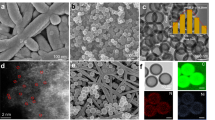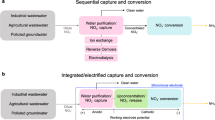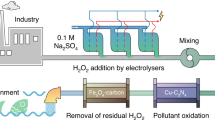Abstract
Combining inorganic catalysts with CO2-fixing microorganisms has displayed a high efficiency for electricity-driven CO2 reduction. However, the maximum throughput can be limited by the low solubility of mediators, such as H2, that deliver reducing equivalents from the electrodes to the microbes. Here we report that the introduction of a biocompatible perfluorocarbon nanoemulsion as a H2 carrier increases the throughput of CO2 reduction into acetic acid by 190%. With the acetogen Sporomusa ovata as a model system, an average acetate titre of 6.4 ± 1.1 g l−1 (107 mM) was achieved in four days with close to 100% Faradaic efficiency. This is equivalent to a productivity of 1.1 mM h−1, among the highest in bioelectrochemical systems. A mechanistic investigation shows that the non-specific binding of perfluorocarbon nanoemulsions promotes the kinetics of H2 transfer and subsequent oxidation by more than threefold. Introducing nanoscale gas carriers is viable to alleviate throughput bottlenecks in the electricity-driven microbial CO2 reduction into commodity chemicals.
This is a preview of subscription content, access via your institution
Access options
Access Nature and 54 other Nature Portfolio journals
Get Nature+, our best-value online-access subscription
$29.99 / 30 days
cancel any time
Subscribe to this journal
Receive 12 digital issues and online access to articles
$119.00 per year
only $9.92 per issue
Buy this article
- Purchase on Springer Link
- Instant access to full article PDF
Prices may be subject to local taxes which are calculated during checkout




Similar content being viewed by others
Data availability
The data that support the plots within this paper and other findings of this study are available from the corresponding author upon reasonable request.
References
Chu, S. & Majumdar, A. Opportunities and challenges for a sustainable energy future. Nature 488, 294–303 (2012).
Nocera, D. G. Solar fuels and solar chemicals industry. Acc. Chem. Res. 50, 616–619 (2017).
Jia, J. et al. Heterogeneous catalytic hydrogenation of CO2 by metal oxides: defect engineering—perfecting imperfection. Chem. Soc. Rev. 46, 4631–4644 (2017).
Dinh, C.-T. et al. CO2 electroreduction to ethylene via hydroxide-mediated copper catalysis at an abrupt interface. Science 360, 783–787 (2018).
White, J. L. et al. Light-driven heterogeneous reduction of carbon dioxide: photocatalysts and photoelectrodes. Chem. Rev. 115, 12888–12935 (2015).
Jouny, M., Luc, W. & Jiao, F. High-rate electroreduction of carbon monoxide to multi-carbon products. Nat. Catal. 1, 748–755 (2018).
Li, J. et al. Efficient electrocatalytic CO2 reduction on a three-phase interface. Nat. Catal. 1, 592–600 (2018).
Bushuyev, O. S. et al. What should we make with CO2 and how can we make it? Joule 2, 825–832 (2018).
Appel, A. M. et al. Frontiers, opportunities, and challenges in biochemical and chemical catalysis of CO2 fixation. Chem. Rev. 113, 6621–6658 (2013).
Liu, C., Colón, B. C., Ziesack, M., Silver, P. A. & Nocera, D. G. Water splitting-biosynthetic system with CO2 reduction efficiencies exceeding photosynthesis. Science 352, 1210–1213 (2016).
Kornienko, N., Zhang, J. Z., Sakimoto, K. K., Yang, P. & Reisner, E. Interfacing Nature’s catalytic machinery with synthetic materials for semi-artificial photosynthesis. Nat. Nanotechnol. 13, 890–899 (2018).
Li, H. et al. Integrated electromicrobial conversion of CO2 to higher alcohols. Science 335, 1596–1596 (2012).
Sakimoto, K. K., Wong, A. B. & Yang, P. Self-photosensitization of nonphotosynthetic bacteria for solar-to-chemical production. Science 351, 74–77 (2015).
Claassens, N. J., Sousa, D. Z., dos Santos, V. A. P. M., de Vos, W. M. & van der Oost, J. Harnessing the power of microbial autotrophy. Nat. Rev. Microbiol. 14, 692–706 (2016).
Brown, K. A. et al. Light-driven dinitrogen reduction catalyzed by a CdS:nitrogenase MoFe protein biohybrid. Science 352, 448–450 (2016).
Liao, J. C., Mi, L., Pontrelli, S. & Luo, S. Fuelling the future: microbial engineering for the production of sustainable biofuels. Nat. Rev. Microbiol. 14, 288–304 (2016).
Cornejo, J. A., Sheng, H., Edri, E., M. Ajo-Franklin, C. & Frei, H. Nanoscale membranes that chemically isolate and electronically wire up the abiotic/biotic interface. Nat. Commun. 9, 2263 (2018).
Rabaey, K. & Rozendal, R. A. Microbial electrosynthesis—revisiting the electrical route for microbial production. Nat. Rev. Microbiol. 8, 706–716 (2010).
Sakimoto, K. K. et al. Physical biology of the materials–microorganism interface. J. Am. Chem. Soc. 140, 1978–1985 (2018).
Milton, R. D., Wang, T., Knoche, K. L. & Minteer, S. D. Tailoring biointerfaces for electrocatalysis. Langmuir 32, 2291–2301 (2016).
Zhang, T. More efficient together. Science 350, 738–739 (2015).
Liu, C., Sakimoto, K. K., Colón, B. C., Silver, P. A. & Nocera, D. G. Ambient nitrogen reduction cycle using a hybrid inorganic–biological system. Proc. Natl Acad. Sci. USA 114, 6450–6455 (2017).
Lubitz, W., Ogata, H., Rüdiger, O. & Reijerse, E. Hydrogenases. Chem. Rev. 114, 4081–4148 (2014).
Liu, C., Nangle, S. N., Colón, B. C., Silver, P. A. & Nocera, D. G. 13C-Labeling the carbon-fixation pathway of a highly efficient artificial photosynthetic system. Faraday Discuss. 198, 529–537 (2017).
Gevantman, L. H. in CRC Handbook of Chemistry and Physics (ed. Haynes, W. M.) Ch. 5 (CRC Press, 2015).
Watanabe, K., Manefield, M., Lee, M. & Kouzuma, A. Electron shuttles in biotechnology. Curr. Opin. Biotechnol. 20, 633–641 (2009).
Squires, J. E. Artificial blood. Science 295, 1002–1005 (2002).
Ju, L. K., Lee, J. F. & Armiger, W. B. Enhancing oxygen transfer in bioreactors by perfluorocarbon emulsions. Biotechnol. Prog. 7, 323–329 (1991).
Yamamoto, S., Honda, H., Shiragami, N. & Unno, H. Enhancement of autotrophic growth rate of Alcaligenes eutrophus in a medium containing perfluorocarbon under low oxygen partial pressure. Biotechnol. Lett. 14, 733–736 (1992).
Dissolving Gases in FLUTEC Liquids (F2 Chemicals Ltd, 2005); http://f2chemicals.com/pdf/technical/Gas%20solubility.pdf
Sletten, E. M. & Swager, T. M. Readily accessible multifunctional fluorous emulsions. Chem. Sci. 7, 5091–5097 (2016).
Sletten, E. M. & Swager, T. M. Fluorofluorophores: fluorescent fluorous chemical tools spanning the visible spectrum. J. Am. Chem. Soc. 136, 13574–13577 (2014).
Möller, B., Oßmer, R., Howard, B. H., Gottschalk, G. & Hippe, H. Sporomusa, a new genus of gram-negative anaerobic bacteria including Sporomusa sphaeroides spec. nov. and Sporomusa ovata spec nov. Arch. Microbiol. 139, 388–396 (1984).
Nevin, K. P., Woodard, T. L., Franks, A. E., Summers, Z. M. & Lovley, D. R. Microbial electrosynthesis: feeding microbes electricity to convert carbon dioxide and water to multicarbon extracellular organic compounds. MBIO 1, e00103 (2010).
Liu, C. et al. Nanowire–bacteria hybrids for unassisted solar carbon dioxide fixation to value-added chemicals. Nano Lett. 15, 3634–3639 (2015).
Aryal, N., Tremblay, P. L., Lizak, D. M. & Zhang, T. Performance of different Sporomusa species for the microbial electrosynthesis of acetate from carbon dioxide. Bioresour. Technol. 233, 184–190 (2017).
LaBelle, E. V. & May, H. D. Energy efficiency and productivity enhancement of microbial electrosynthesis of acetate. Front. Microbiol. 8, 756 (2017).
Paseka, I. & Velicka, J. Hydrogen evolution and hydrogen sorption on amorphous smooth Me−P(x) (Me = Ni, Co and Fe−Ni) electrodes. Electrochim. Acta 42, 237–242 (1997).
Jiang, N., You, B., Sheng, M. & Sun, Y. Electrodeposited cobalt–phosphorous-derived films as competent bifunctional catalysts for overall water splitting. Angew. Chem. Int. Ed. 54, 6251–6254 (2015).
Haas, T., Krause, R., Weber, R., Demler, M. & Schmid, G. Technical photosynthesis involving CO2 electrolysis and fermentation. Nat. Catal. 1, 32–39 (2018).
Bard, A. J. & Faulkner, L. R. Electrochemical Methods: Fundamentals and Applications 2nd edn, Ch. 9 (John Wiley & Sons, Hoboken, 2001).
Konopka, S. J. & McDuffie, B. Diffusion coefficients of ferri- and ferrocyanide ions in aqueous media, using twin-electrode thin-layer electrochemistry. Anal. Chem. 42, 1741–1746 (1970).
Jeremiasse, A. W., Hamelers, H. V. M., Kleijn, J. M. & Buisman, C. J. N. Use of biocompatible buffers to reduce the concentration overpotential for hydrogen evolution. Environ. Sci. Technol. 43, 6882–6887 (2009).
Acknowledgements
We acknowledge B. Natinsky for the diffusion ordered spectroscopy experiments. We also thank S. Kosuri for the use of flow cytometry facilities and the Molecular Instrumentation Center at the University of California, Los Angeles for sample characterizations. D.A.E. acknowledges the financial support of an NIH training grant (5T32GM067555-12). J.A.I. is supported by a Eugene V. Cota-Robles fellowship. E.M.S. and C.L. acknowledge start-up funds from the University of California, Los Angeles and the financial support of the Jeffery and Helo Zink Endowed Professional Development Term Chair (to C.L.) and the John D. McTague Career Development Term Chair (to E.M.S.).
Author information
Authors and Affiliations
Contributions
C.L. supervised the project. C.L. and R.M.R. designed experiments and wrote the paper. R.M.R. conducted and coordinated the majority of the experiments with the assistance of S.H. D.A.E. and J.O.C. prepared the nanoemulsions under supervision of E.M.S. X.G. conducted the RDE experiments. J.A.I. performed experiments of flow cytometry. All the authors discussed the results and assisted during the manuscript preparation.
Corresponding author
Ethics declarations
Competing interests
The authors declare no competing interests.
Additional information
Publisher’s note: Springer Nature remains neutral with regard to jurisdictional claims in published maps and institutional affiliations.
Supplementary information
Supplementary Information
Supplementary Methods, Supplementary Discussion, Supplementary Tables 1–4, Supplementary Figures 1–11, Supplementary References
Rights and permissions
About this article
Cite this article
Rodrigues, R.M., Guan, X., Iñiguez, J.A. et al. Perfluorocarbon nanoemulsion promotes the delivery of reducing equivalents for electricity-driven microbial CO2 reduction. Nat Catal 2, 407–414 (2019). https://doi.org/10.1038/s41929-019-0264-0
Received:
Accepted:
Published:
Issue Date:
DOI: https://doi.org/10.1038/s41929-019-0264-0
This article is cited by
-
Enhancement of acetate production in hydrogen-mediated microbial electrosynthesis reactors by addition of silica nanoparticles
Bioresources and Bioprocessing (2023)
-
Metabolic engineering strategies for microbial utilization of C1 feedstocks
Systems Microbiology and Biomanufacturing (2023)
-
Cu2+1O/CuOx heterostructures promote the electrosynthesis of C2+ products from CO2
Nano Research (2023)
-
Co anchored on porphyrinic triazine-based frameworks with excellent biocompatibility for conversion of CO2 in H2-mediated microbial electrosynthesis
Frontiers of Chemical Science and Engineering (2022)
-
Recent advances in nature-inspired nanocatalytic reduction of organic molecules with water
Nano Research (2022)



